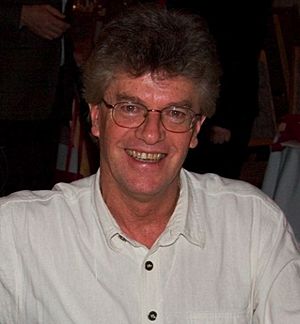Godfried Toussaint facts for kids
Godfried Theodore Patrick Toussaint (born 1944 – died July 2019) was a Canadian computer scientist and professor. He led the computer science program at New York University Abu Dhabi in the United Arab Emirates. Many people called him the 'father of computational geometry' in Canada.
He studied how computers can solve problems using shapes and spaces. This is called computational geometry. He also worked on things like how computers recognize patterns, plan movements, and create images. His interests also included art, old drawing methods, and how computers can understand music.
Godfried Toussaint helped start two big conferences about computational geometry. These were the Annual ACM Symposium on Computational Geometry and the annual Canadian Conference on Computational Geometry.
With Selim Akl, he created a clever computer method called the "Akl–Toussaint algorithm." It helps find the "convex hull" of a group of points. This is like finding the smallest rubber band that can stretch around all of them. In 1980, he also introduced the relative neighborhood graph (RNG). This is a special way to connect points that helps computers recognize patterns. He showed how it related to other important computer graphs, like the minimum spanning tree. These related graphs are now known as the Toussaint hierarchy.
Biography
Godfried Toussaint was born in Belgium in 1944. He went to the University of Tulsa and graduated in 1968. Then, he continued his studies at the University of British Columbia, where he earned his Ph.D. in 1972. His main research for his Ph.D. was about how computers can recognize patterns.
In 1972, he joined the faculty at McGill University. He became a professor emeritus there in 2007, which means he retired but kept his title. After leaving McGill, he became a professor and head of the computer science department at New York University Abu Dhabi.
He passed away in July 2019 in Tokyo, Japan. He was in Tokyo to share his work on how to measure symmetry in digital patterns.
Mathematical Research in Music
Godfried Toussaint spent a year at Harvard University studying music. He researched how to measure how similar different pieces of music are. From 2005, he also worked at the Centre for Interdisciplinary Research in Music Media and Technology at McGill University.
He used methods from computational geometry and discrete mathematics to study music. He was especially interested in rhythm. In 2004, he made an amazing discovery. He found that the Euclidean algorithm, which is used to find the greatest common divisor of two numbers, can create almost all the most important traditional rhythms from around the world. His work on using math to trace the history of Flamenco music was even featured on two Canadian television programs.
Awards and Honors
Godfried Toussaint received many awards for his important work:
- In 2018, he earned a Lifetime Achievement Award from the Canadian Association of Computer Science.
- In 1978, he won the Pattern Recognition Society's Best Paper of the Year Award.
- In 1985, he received a two-year Senior Research Fellowship from the Canada Council for the Arts.
- In 1988, he was given an Advanced Systems Institute Fellowship.
- In 1995, he received the Vice-Chancellor's Research Best-Practice Fellowship from the University of Newcastle in Australia.
- In 1996, he won the Service Award from the Canadian Image Processing and Pattern Recognition Society. This was for his great contributions to research and teaching in computational geometry.
- In May 2001, he was honored with the David Thomson Award at McGill University. This award recognized his excellent work in guiding and teaching graduate students.
- In 2009, he won a Radcliffe Fellowship from the Radcliffe Institute for Advanced Study at Harvard University. This allowed him to research the history and relationships of musical rhythms around the world.


